|
GREGORY DEVA 60 BACKPACK
TEST SERIES BY FRANCES PENN
LONG-TERM REPORT
December 01, 2015
CLICK HERE TO SKIP TO THE FIELD REPORT
CLICK HERE TO SKIP TO THE LONG-TERM REPORT
TESTER INFORMATION
|
NAME:
|
Frances Penn
|
|
EMAIL:
|
oldhikergirl AT yahoo DOT com
|
|
AGE:
|
59
|
|
LOCATION:
|
Santa Ana, California USA
|
|
GENDER:
|
F
|
|
HEIGHT:
|
5' 9" (1.75 m)
|
|
WEIGHT:
|
130 lb (59.00 kg)
|
I have been backpacking for eight years mostly on long weekends in Southern California with two or more 5-day trips per year in the Sierras. My total daypack weight, including food and water, is usually 15 lb (7 kg) and my total backpack weight, including food and water, is usually 22-26 lb (10-12 kg) depending on the need for a bear canister. I have converted to a tarp and bivy sleep system instead of a tent to keep my pack weight down. I have experienced all night rain, hail, heavy winds, camping in snow once, but mostly fair weather.
INITIAL REPORT
PRODUCT INFORMATION & SPECIFICATIONS
Manufacturer: Gregory Mountain Products
Year of Manufacture: 2015
Manufacturer's Website: http://gregorypacks.com
MSRP: US $299
Listed Weight: 4 lb 14 oz (2.24 kg)
Measured Weight with Sidekick daypack: 5 lb 14 oz (2.33 kg)
Sidekick daypack weight: 4.3 oz (122 g)
Colors Available: Ruby Red, Egyptian Blue and Charoal Gray
Color Tested: Ruby Red
Sizes Available: Extra Small, Small and Medium
Size Tested: Medium
Torso Sizes: Extra Small is 14 to 16 in (36 to 41 cm), Small is 16 to 18 in (41 to 46 cm), Medium is 18 to 20 in (46 to 51 cm)
My torso is 19 in (46 cm)
My chest is 32 in (81 cm)
My waist is 30 in (76 cm)
Gear Capacity: Extra Small is 56 Liters (3,417 ci), Small is 60 Liters (3,661 ci) and Medium is 64 Liters (3,906 ci)
Maximum carry capacity: 50 lb (23 kg)
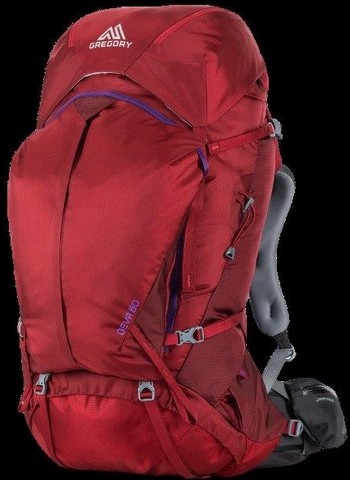 | | Photo from Gregory website |
The Deva 60 is a women-specific mid-sized full-featured backpack designed for long weekend trips. It is a top loading pack with a U-shaped front zipper and a bottom sleeping bag zippered compartment with a detachable internal divider. There are bottom straps for extra gear capacity.
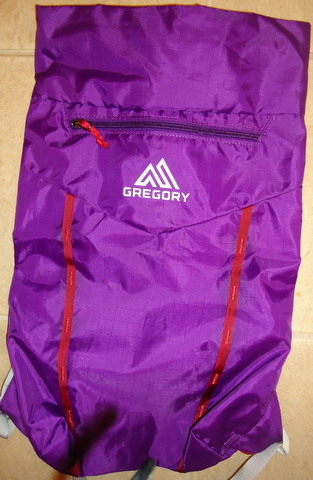 | | Sidekick day pack |
The included Sidekick can be used as a summit or daypack on long trips utilizing a base camp. It can also be used as an internal hanging reservoir sleeve, attached outside for extra carrying capacity, or used as a stuff sack for pack contents. It closes on top using a drawstring and contains a small zippered pocket at the top.
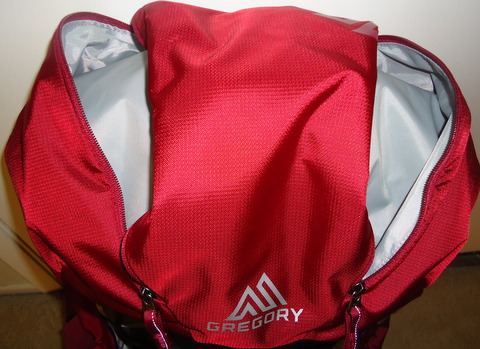 | | lid pockets |
The lid has two side-by-side zippered pockets on top and one security pocket underneath.
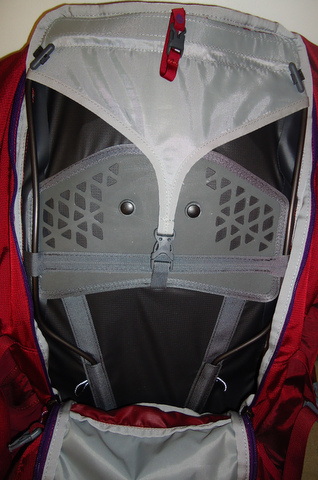 | | suspension |
The Response A3W Suspension includes a vented, formed back panel with LifeSpan foam and a silicone lumbar grip zone. There is a LumbarTune removable 10 mm (0.39 in) insert to customize the contouring of the backpanel. The QuickSwap 3D interchangeable pre-curved LifeSpan EVA foam harness and hipbelt are available in multiple sizes.
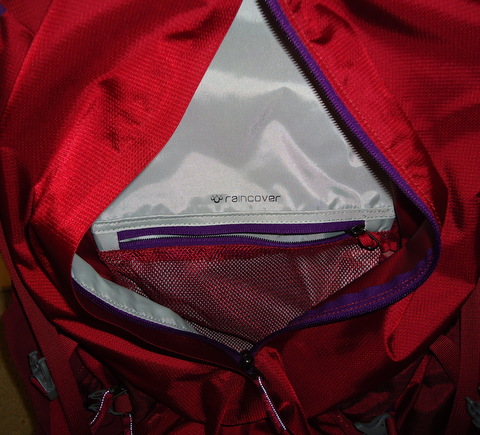 | | rain cover pocket |
The removable rain cover stows in its own zippered pocket inside the front vertical zippered panel.
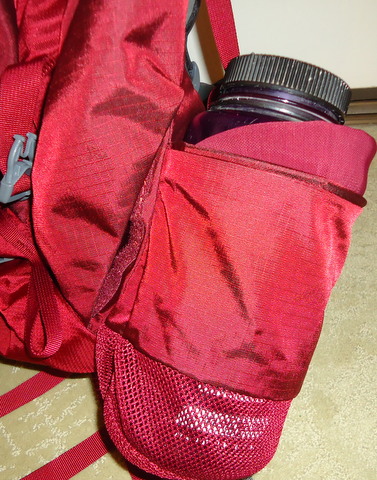 | | bottle holster |
The bottle holster is on the right when wearing the pack and has its own integrated stow pocket. The bottom is mesh and there is a drawstring holder to keep the bottle in place. There is also a stretch mesh pocket on the left side when wearing the pack.
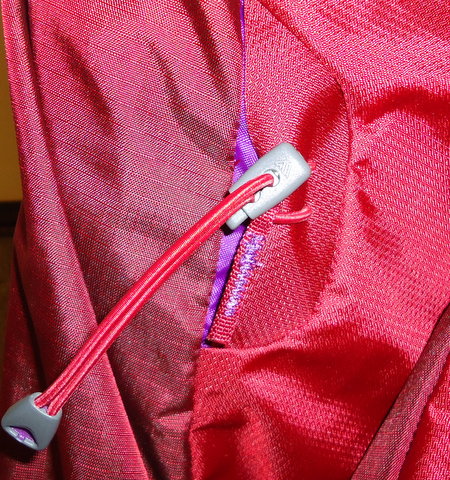 | | shock locks |
There are ice axe loops and upper reinforced shock locks for ice tool and trekking pole attachment on both sides.
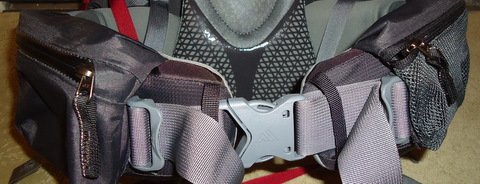 | | hipbelt pockets |
The right hipbelt accessory pocket is WeatherShield PU-coated with a YKK AquaGuardŽ zipper. The left hipbelt accessory pocket is mesh. Both hipbelt pockets are sewn on the top and fasten to the hipbelt with hook-and-loop over the belt straps to allow the strap length to be adjusted.
INITIAL IMPRESSIONS
There are a lot of features on this backpack. It appears that Gregory included every feature imaginable in this backpack and its weight confirms my impression.
READING THE INSTRUCTIONS
The instructions include all of the information listed above along with the guarantee which states the backpack may be returned for repair or replacement at no cost. The guarantee applies to damage resulting from defective materials or workmanship, not wear and tear or "unreasonable use".
TRYING IT OUT
I packed the Deva for an upcoming weekend backpack trip and my usual gear fits. I noticed the left side mesh pocket is small and a full one-liter water bottle barely fits. A one-liter bottle does fit in the water bottle holster. Depending on the trip, I like to pack my tent in one of the outside pockets to save room inside the pack for my bear canister. I notice the tent does not fit in the side pocket of this pack. The bottom straps fit my full size waffle type sleeping pad with additional strap capacity. The front pocket is ample and will be convenient for clothing access during the changing temperatures. The two lid pockets are large enough to handle all of the smaller items I usually carry. Having two smaller pockets allows me to separate the larger items from the smaller items. Hopefully this organization won't be too confusing out on the trail.
SUMMARY
This pack has more features than I am accustomed to having. I can't wait to get the pack out on the trail and try out all the organizational features. I hope I don't lose anything in the many pockets available.
FIELD REPORT
FIELD LOCATIONS AND CONDITIONS
Trip #1:
Location: Round Valley Campground near San Jacinto, California, USA
Elevation: 9,200 ft (2,800 m)
Trip Duration: 3 days, 2 nights
Trail Conditions: on dirt trail
Temperature: 40 to 70 F (4 to 21 C)
Weather: sunny
Trip #2:
Location: Icehouse Canyon trail to saddle near Baldy, California, USA
Elevation: 7,600 ft (2,300 m)
Trip Duration: 2 days, 1 night
Trail Conditions: on forest dirt trail
Temperature: 40 to 70 F (4 to 21 C)
Weather: sunny
Trip #3
Location: San Gorgonio, California, USA
Elevation: 11,503 ft (3,506 m)
Trip Duration: 3 days, 2 nights
Trail Conditions: on forest dirt trail
Temperature: 40 to 70 F (4 to 21 C)
Weather: sunny with cool nights and windy on the peak
Trip #4:
Location: Cucamonga Peak near Baldy, California, USA
Elevation: 8,900 ft (2,700 m)
Trip Duration: 2 days, 1 night
Trail Conditions: on forest dirt trail
Temperature: 40 to 70 F (4 to 21 C)
Weather: sunny with a cool wind
Trip #5:
Location: Butler Peak near Big Bear, California, USA
Elevation: 8,500 ft (2,600 m)
Trip Duration: 2 days, 1 night
Trail Conditions: on forest dirt trail
Temperature: 70 F (21 C)
Weather: sunny
Trip #6:
Location: Delamar Peak near Big Bear, California, USA
Elevation: 8,400 ft (2,560 m)
Trip Duration: 2 days, 1 night
Trail Conditions: on forest dirt trail
Temperature: 70 F (21 C)
Weather: sunny
Trip #7:
Location: Manker Flats trail to Mt. Baldy, California, USA
Elevation: 10,060 ft (3,066 m)
Trip Duration: 1 day hike
Trail Conditions: on forest dirt trail
Temperature: 70 F (21 C)
Weather: sunny with a breeze on the ridges and the peak
Trip #8
Location: Sugarloaf Mountain area, Big Bear Lake, California USA
Elevation: 9,200 ft (2,800 m)
Trip Duration: 2 days, 1 night
Trail Conditions: on and off trail in the forest with stream crossings
Temperatures: 40 to 60 F (4 to 15 C)
Weather: sunny
Trip #9:
Location: Round Valley Campground near San Jacinto, California, USA
Elevation: 9,200 ft (2,800 m)
Trip Duration: 2 days, 1 night
Trail Conditions: on dirt trail
Temperature: 70 F (21 C)
Weather: sunny
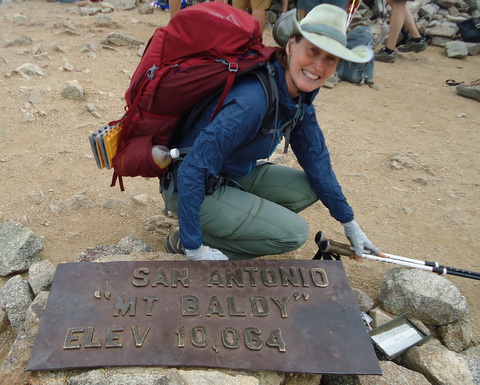 | | on top of Baldy |
PERFORMANCE IN THE FIELD
All of my usual gear fits into this pack. My challenge was finding the optimum location for every piece of gear. I was using a Tarptent one-person tent during this test period because I was training for a portion of the John Muir Trail. I didn't use my tarp and bivy setup because I was concerned about rain on the long JMT trip. I tried several different locations for my gear in this pack and finally settled on the configuration that worked the best.
The suspension fits my torso and feels like it is designed for a woman's shape. Because I was training, I carried between 30 and 35 pounds (13 to 15 g), which is more weight than I would prefer. The suspension felt like it carried the weight with good distribution.
The sidekick day pack worked well as an internal sleeve to hold my water reservoir. On one of the trips, I attached the sidekick day pack to the outside of the pack to try out this overflow option. It worked well and is a nice extra option to have available.
The lid is the largest I can remember using lately. Having the top pocket divided down the middle with zippers on each side made it easier to separate and locate items. After minimal adjustment time, I was ultimately able to find the smaller pieces of gear regularly stowed in the multiple lid pockets.
The water bottle stow pocket is the perfect size for a one-liter water bottle. The angle and location of the pocket makes it easy to reach back and grab the bottle. The only problem is if I lean over to pick up my trekking poles or some other item from the ground, the bottle slips out of the pocket easily.
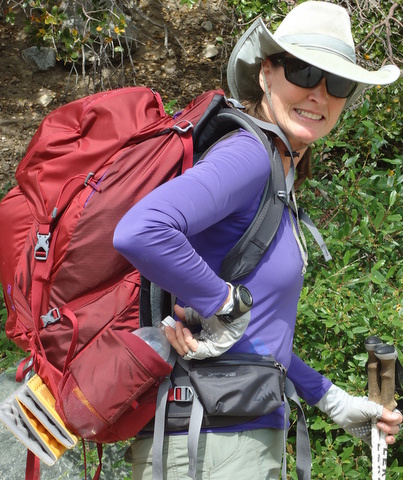 | | easy access to side water bottle pocket |
The mesh side pocket on the opposite side fits a one-liter bottle. This pocket does not fit larger items like a one-person tent or a sleeping pad that I sometimes like to pack in a side pocket. This saves the bulk of the inside of the pack for a bear canister, which is required in some areas.
The front vertical zippered panel proved to be a convenient place to carry my bathroom bag and extra layers that were not needed as the weather warmed during the middle of the day. On the first trip, I packed too many clothing items in this pocket and it felt like the pack was pulling me over backwards. I removed a few items and relocated them in the main area of the pack and this resolved the issue.
The many compression straps make it easy to adjust the pack load and serve as available loops for carrying small items like my camp sandals outside the pack.
The hipbelt pockets are a very useful size for small items like lip balm, camera and a protein bar on the trail.
The large hipbelt pads are formed into a half circle with a seam halfway down the middle to fit around the hip bones. They were not comfortable on my hips. I tried placing the hipbelt just above my hips, directly on my hips, and just below my hips. I had to make these adjustments multiple times each day to achieve some minimal comfort. I was hoping the hipbelt would soften and form around my hips with use. This hasn't happened yet.
The bottom straps are large enough to hold a sleeping pad or a small tent, but they are not long enough to go around a bear canister.
SUMMARY
This is a full-featured pack with a lot of very well thought out features that are useful for organizing gear. All of these extra features combine to make the pack heavier than I would usually carry. Because of my minimalist style, I have become accustomed to a simple backpack with no pockets, separate compartments, top lid or accessories. It was a fun experience trying the different pockets, zippers, straps and compartments for a change of pace.
LONG-TERM REPORT
LONG-TERM TEST LOCATIONS AND CONDITIONS
Trip 10:
Location: Palomar Mountain area, California USA
Elevation: 6,100 ft (1,860 m)
Trip Duration: 2 days, 1 night
Trail Conditions: on dirt trail
Temperature: 40 to 70 F (4 to 21 C)
Weather: sunny the first day with rain at night and the next morning
PERFORMANCE IN THE FIELD
The pack and all of its many features have continued to perform well as mentioned in my Field Report. The pack has a few small scrapes and minor dirt spots from use. These are so minimal that it isn't necessary to clean them yet. Overall, the pack is in great shape with no damage that would adversely affect the features.
The hipbelt pads remain uncomfortable. I was hoping that with use they would soften and form around my hips, but that hasn't happened.
SUMMARY
Considering my minimalist style of backpacking, this full-featured pack has more features than I need. The many features contribute to the weight and bulk of the pack. The many features allow gear to be stored in different configurations depending on the weather and trip duration.
This test series is now concluded. Many thanks to BackpackGearTest.org and Gregory for this testing opportunity.
This report was created with the BackpackGearTest.org Report Writer Version 1.
Copyright 2015. All rights reserved.
Read more gear reviews by Frances Penn
|




